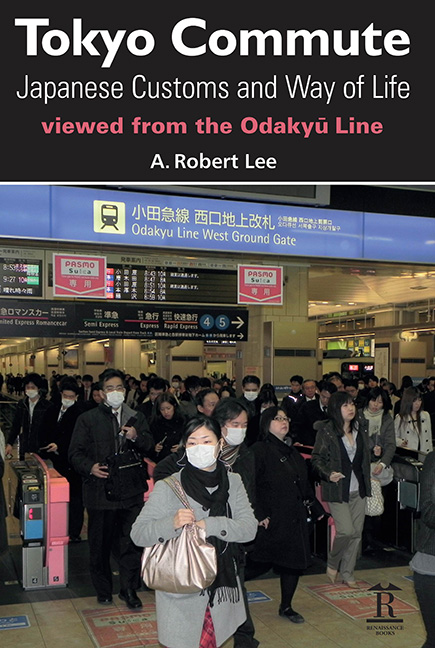Book contents
- Frontmatter
- Dedication
- Acknowledgements
- Contents
- 1 Odakyū-sen
- 2 Shinjuku Station
- 3 Shinjuku
- 4 Mukōgaoka-yūen North
- 5 Mukōgaoka-yūen South
- 6 Mukōgaoka-yūen Platform
- 7 January Monday
- 8 Odakyū Notables
- 9 Odakyū Line Sounds Familiar
- 10 Train Notices
- 11 Odakyū Commercials
- 12 February Tuesday
- 13 Odakyū Keitaispracht
- 14 By-line, Setagaya Line
- 15 March Wednesday
- 16 Odakyū Day-out Sendagi
- 17 Shimo-Kitazawa
- 18 Bicycle!
- 19 Odakyū Bike Interview – Toda-san
- 20 International Interlude via Narita Airport
- 21 Keitai Train Culture
- 22 April Thursday
- 23 Odakyū Tamagawa
- 24 Station Sights
- 25 Odakyū-sen, Yoyogi-Hachiman Eki
- 26 May Friday
- 27 Mukoōgaoka-yūen, Day for Night
- 28 Odakyū Day-out, Hakone
- 29 June Saturday
- 30 Odakyū Commercials
- 31 Odakyū Smokes
- 32 By-line, Nambu Line
- 33 Odakyū Bag Watch
- 34 Seijo Times
- 35 Odakyū Day-out, Yokohama
- 36 July Sunday
- 37 Odakyū Trains of Thought
- 38 Train Signs, Train Sounds
- 39 By-line, Tama Express
- 40 August Monday
- 41 Odakyū Day-out, Chiba
- 42 September Tuesday
- 43 Odakyū Lady-grooming
- 44 Odakyū and Near-Odakyū Women’s Hairday
- 45 Odakyū Evenings-out
- 46 October Wednesday
- 47 Odakyū Day-out, Ibaraki
- 48 Chikan! Odakyū Misbehaviour
- 49 November Thursday
- 50 Odakyū Blues
- 51 Odakyū Men’s Haircut
- 52 Odakyū Day-out, Ō-Sumo
- 53 December Friday
- 54 Odakyū Store
- 55 Odakyū Bookshelf
- 56 Last Train
- Glossary
- Frontmatter
- Dedication
- Acknowledgements
- Contents
- 1 Odakyū-sen
- 2 Shinjuku Station
- 3 Shinjuku
- 4 Mukōgaoka-yūen North
- 5 Mukōgaoka-yūen South
- 6 Mukōgaoka-yūen Platform
- 7 January Monday
- 8 Odakyū Notables
- 9 Odakyū Line Sounds Familiar
- 10 Train Notices
- 11 Odakyū Commercials
- 12 February Tuesday
- 13 Odakyū Keitaispracht
- 14 By-line, Setagaya Line
- 15 March Wednesday
- 16 Odakyū Day-out Sendagi
- 17 Shimo-Kitazawa
- 18 Bicycle!
- 19 Odakyū Bike Interview – Toda-san
- 20 International Interlude via Narita Airport
- 21 Keitai Train Culture
- 22 April Thursday
- 23 Odakyū Tamagawa
- 24 Station Sights
- 25 Odakyū-sen, Yoyogi-Hachiman Eki
- 26 May Friday
- 27 Mukoōgaoka-yūen, Day for Night
- 28 Odakyū Day-out, Hakone
- 29 June Saturday
- 30 Odakyū Commercials
- 31 Odakyū Smokes
- 32 By-line, Nambu Line
- 33 Odakyū Bag Watch
- 34 Seijo Times
- 35 Odakyū Day-out, Yokohama
- 36 July Sunday
- 37 Odakyū Trains of Thought
- 38 Train Signs, Train Sounds
- 39 By-line, Tama Express
- 40 August Monday
- 41 Odakyū Day-out, Chiba
- 42 September Tuesday
- 43 Odakyū Lady-grooming
- 44 Odakyū and Near-Odakyū Women’s Hairday
- 45 Odakyū Evenings-out
- 46 October Wednesday
- 47 Odakyū Day-out, Ibaraki
- 48 Chikan! Odakyū Misbehaviour
- 49 November Thursday
- 50 Odakyū Blues
- 51 Odakyū Men’s Haircut
- 52 Odakyū Day-out, Ō-Sumo
- 53 December Friday
- 54 Odakyū Store
- 55 Odakyū Bookshelf
- 56 Last Train
- Glossary
Summary
TARO OKAMOTO (1911-1996)
Mukōgaoka-yūen's own. Well almost. Japan's Picasso as often called. Painter. Sculptor. One of the nation's best known artmoderns. The offspring of celebrated parents – his mother, Okamoto Kanoko, the tanka-writer and novelist of The Dying Crane/ Tsuri ha Yamiki (1931) and Portrait of an Old Geisha/Rogistō (1938) and his father, Ippei Okamoto, admired manga cartoonist. Born in Kawasakishi, raised in Tokyo's Aoyama District, these parents took him to both Europe and America – even as he launched himself as an oilpainter. Why Mukogaōka-yuen? Because not a township mile from the station in parkland is the Taro Okamoto Museum. ‘Art is explosion’, ‘Art is magic’, became Okamoto's manifestos. Both track back into his modernist-surrealist apprentice years. Fellow-expatriate Parisian alongside Picasso lui-meme, Mondrian and Kandinsky, and drawn to the sway of Gaudi, Breton, Max Ernst, Louis Aragon. Japan-returnee in 1941 on account of the war, his work proliferates, ever the vital presence – and in 1991 he gives 352 pieces of his brilliantly coloured paint and sculpture creations to Kawasaki-shi. Hence the creation of the Museum, and in Mukōgaoka-yuen. Within walking distance of the Odakyū Line, hence Okamoto's Mukōgaoka-yūen.
Fame most came his way with the iconic Tower of the Sun, the dish-like solar face and outspread wings which became the signature of Osaka's Expo 1970, the first world fair held in Asia. It compares with the octopus-legged figure in the Mukōgaoka park, another sculptural upright with raised white wing-arms, or the street-side sunflower faces in up-market Omotesandō (Chiyoda Line from the Odakyū). But no train-connection now better serves than Okamoto's ‘Myth of Tomorrow’ (Asu no Shinwa), his huge apocalyptic mural first painted in Mexico in 1967 in the style of Diego Rivera and the other great Mexican muralistas and as of November 2008 installed in Shibuya Station. An exploding human body at its centre with footfalls of Hiroshima/Nagasaki, if not all warfare. Splinters of colour. A raptor bird head. Rivulets of blood red. A memorial. A warning.
- Type
- Chapter
- Information
- Tokyo CommuteJapanese Customs and Way of Life Viewed from the Odakyū Line, pp. 38 - 44Publisher: Amsterdam University PressPrint publication year: 2011



